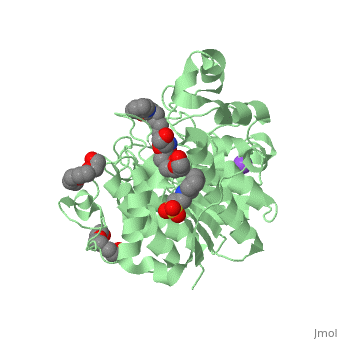Elizabeth A. Dunlap/Sandbox 1
From Proteopedia
(Difference between revisions)
| Line 19: | Line 19: | ||
== Mechanism == | == Mechanism == | ||
| - | Zolina is a potent nanomolar inhibitor of histone deacetylase (HDAC) activity, and this inhibition of activity can alternate the transcription of numerous genes via acetylation and transcription factors. It induces growth arrest, differentiation, or apoptosis in a variety of transformed cells. Zolinza induces up to a nine-fold increase in p21WAF1, a cell kinase inhibitor, mRNA and protein in T24 bladder carcinoma cells. This is caused by an increase in the rate of gene transcription associated with acetylation of the histones H3 and H4, associated with the p21WAF1 promoter. Zolinza also promotes the acetylation of numerous transcription factors like the androgen receptor, E2F-1, YY1, Smad7, EKLF, etc. In addition to histones and transcription factors, it also shows the acetylation of lysine residues of proteins, such as a-tubulin and protein Hsp90. Inhibition of HDAC6 activity leads to acetylation and the disruption of Hsp90, which leads to the decreased of progrowth activity and survival of proteins such as Bcr-Abl, mutant FLT-3, c-Raf and AKT in human leukaemia cells. Zolina has the ability to influence the ability of tumor cells to undergo mitosis by disrupting the cell cycle and induce apoptosis of tumor cells by targeting cell cycle checkpoints. In vitro studies show that HDAC inhibitors create spindles that interfere with chromosome attachment, resulting in mitotic accumulation without affecting microtubules. | + | Zolina is a potent nanomolar inhibitor of histone deacetylase (HDAC) activity, and this inhibition of activity can alternate the transcription of numerous genes via acetylation and transcription factors. It induces growth arrest, differentiation, or apoptosis in a variety of transformed cells. Zolinza induces up to a nine-fold increase in p21WAF1, a cell kinase inhibitor, mRNA and protein in T24 bladder carcinoma cells. This is caused by an increase in the rate of gene transcription associated with acetylation of the histones H3 and H4, associated with the p21WAF1 promoter. Zolinza also promotes the acetylation of numerous transcription factors like the androgen receptor, E2F-1, YY1, Smad7, EKLF, etc. In addition to histones and transcription factors, it also shows the acetylation of lysine residues of proteins, such as a-tubulin and protein Hsp90. Inhibition of HDAC6 activity leads to acetylation and the disruption of Hsp90, which leads to the decreased of progrowth activity and survival of proteins such as Bcr-Abl, mutant FLT-3, c-Raf and AKT in human leukaemia cells. Zolina has the ability to influence the ability of tumor cells to undergo mitosis by disrupting the cell cycle and induce apoptosis of tumor cells by targeting cell cycle checkpoints. In vitro studies show that HDAC inhibitors create spindles that interfere with chromosome attachment, resulting in mitotic accumulation without affecting microtubules <ref name="five">Bubna, A. K. (2015). Vorinostat—An Overview. Indian Journal of Dermatology, 60(4), 419. |
| + | http://doi.org/10.4103/0019-5154.160511</ref>. | ||
== References == | == References == | ||
<references/> | <references/> | ||
Revision as of 23:30, 29 March 2017
Zolinza
| |||||||||||

